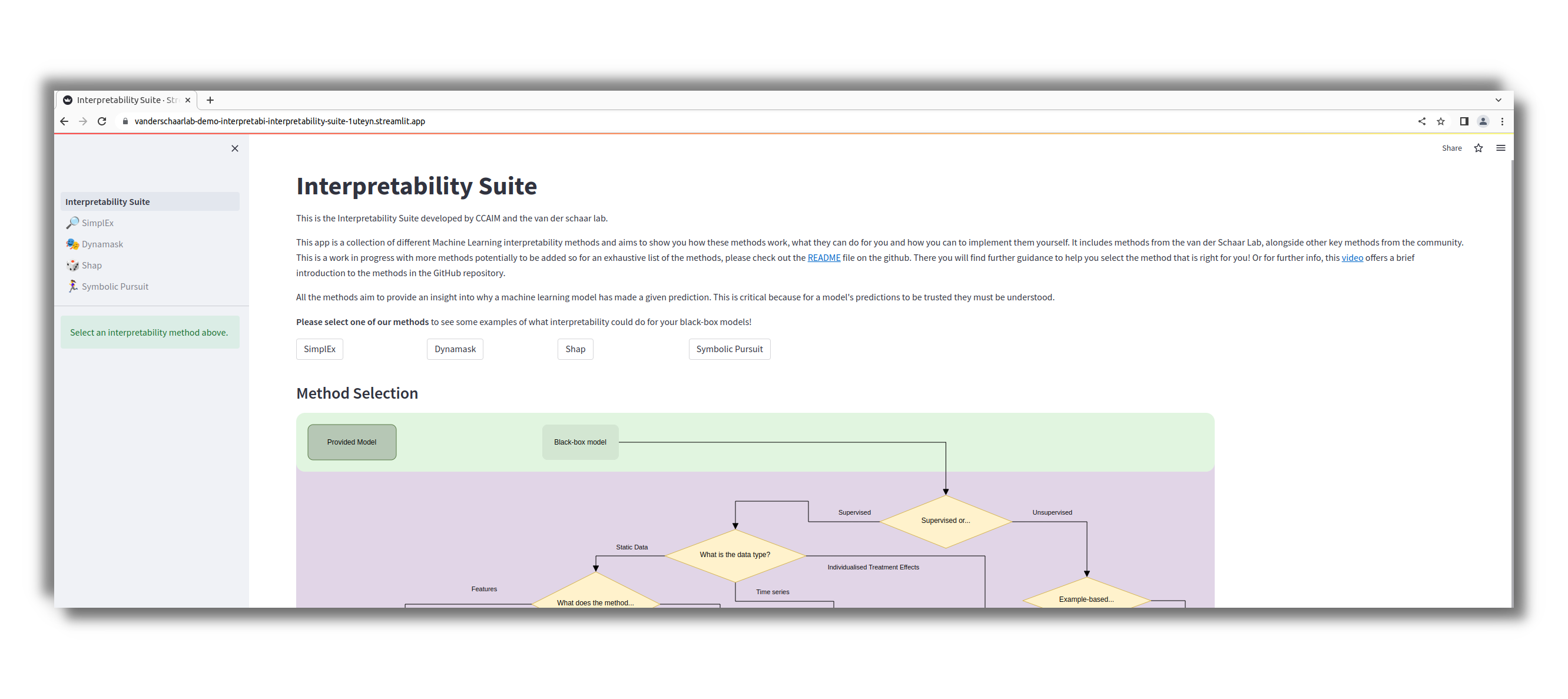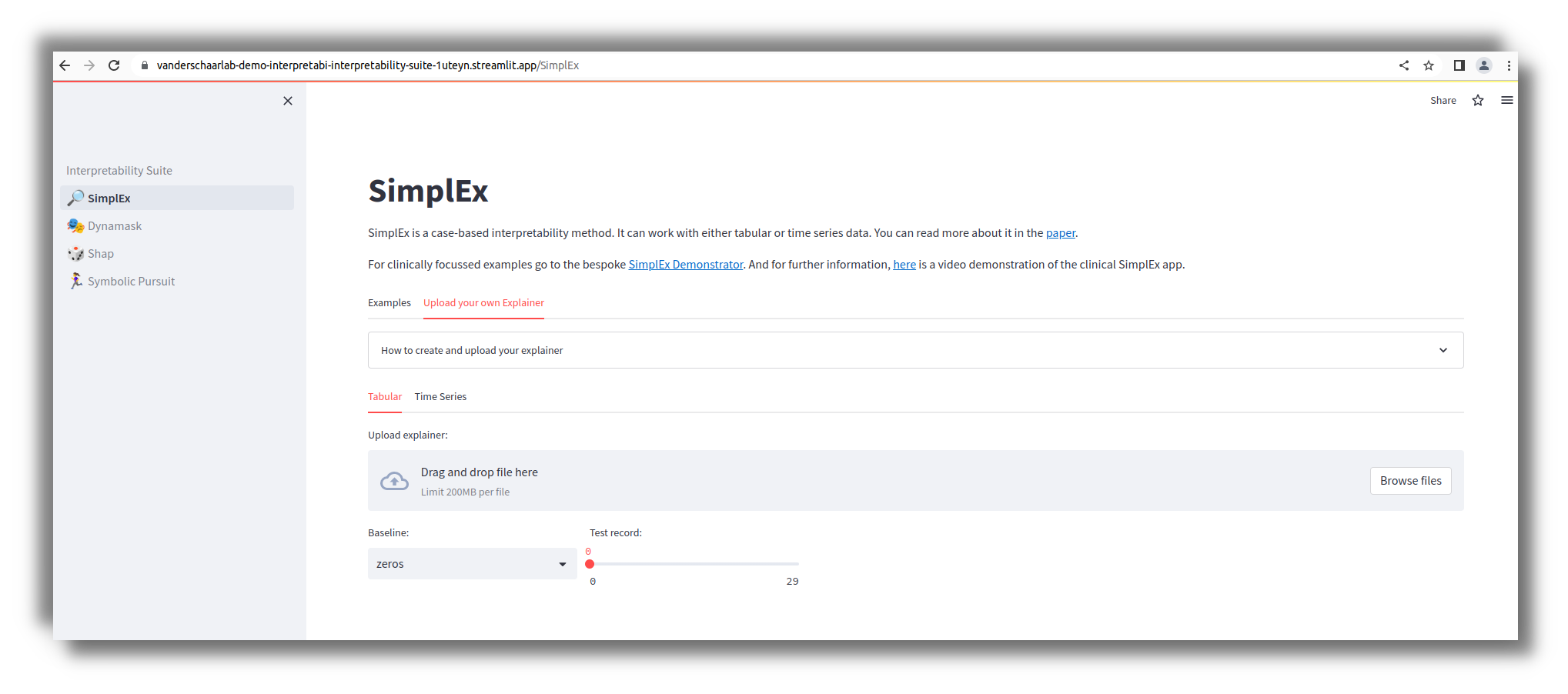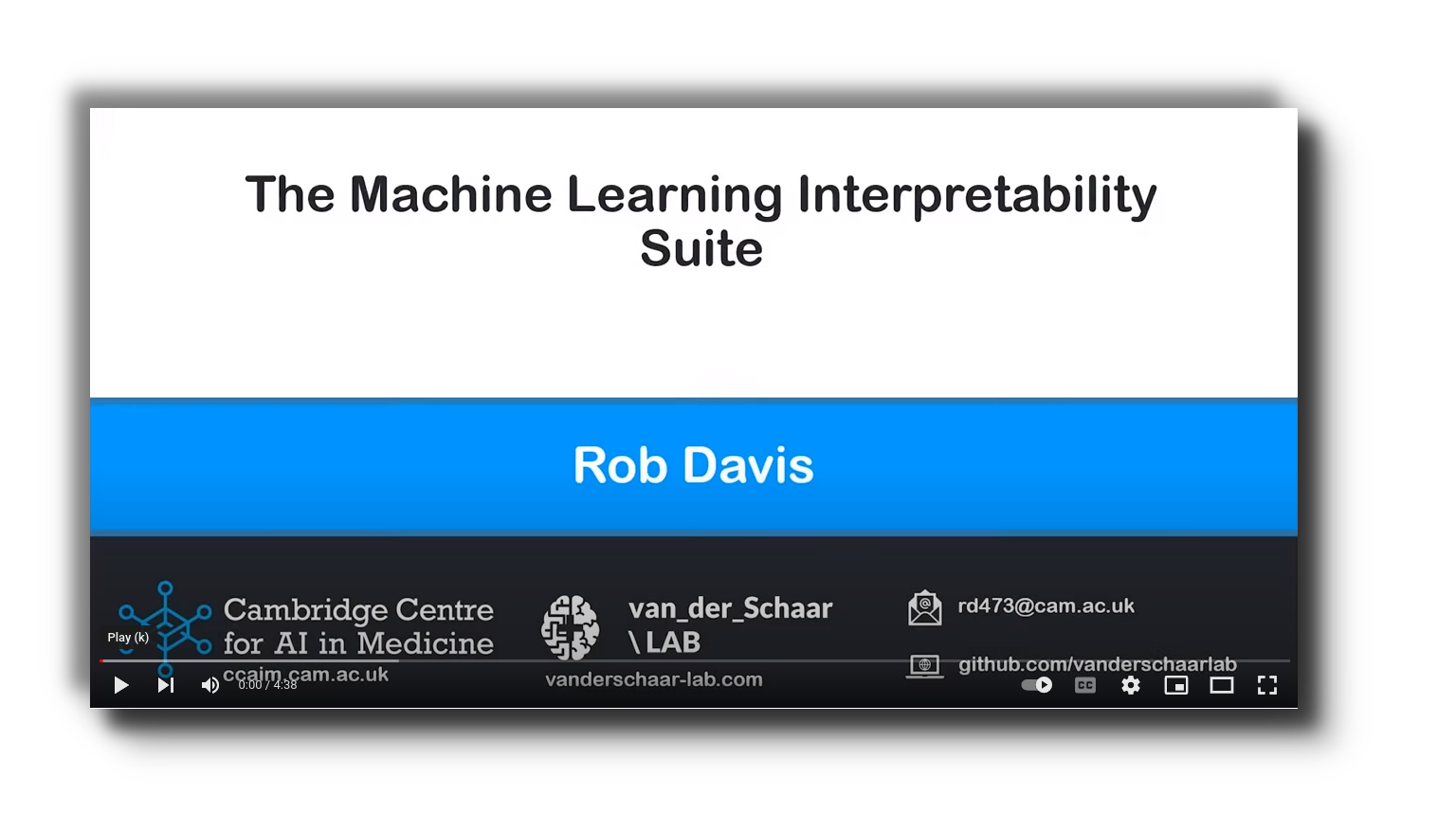This repository collects different Machine Learning interpretability methods and aims to act as a reference where the user can select the method best suited for their needs. All the methods aim to provide an insight into why a machine learning model has made a given prediction. This is critical because for a model's predictions to be trusted they must be understood.
- Background
- Interface
- Explainers
- Implementation and Notebooks
- Explainers By Model Type
- Generalized and Personalized Explainers
The Machine Learning (ML) community has produced incredible models for making highly accurate predictions and classifications across many fields. However, uptake of these models into settings outside of the ML community faces a key barrier: Interpretability. If a human cannot understand why a decision has been made by a machine, they cannot be reasonably expected to act on that decision with full confidence, particularly in a high-stakes environment such as medicine. Therefore making the decisions of "Black-Box" models more transparent is of vital importance. For more information see this blog post.
This GitHub repository aims to act as a home for interpretability methods, where the state-of-the-art models can be found for every application. All the linked van der Schaar Lab repositories on this page are pytorch compatible. Pytorch versions of the other methods are available on public libraries, such as captum.
This video is a quick introduction to our Interpretability Suite. It discusses why ML interpretability is so important and shows the array of different methods developed by the van der Schaar Lab that are available on this GitHub page.
The Interpretability Suite provides a common python interface for the following interpretability methods: SimplEx, Dynamask, shap, and Symbolic Pursuit. Each of these methods are also included in our user interface. To guarantee compatibility with the app please create your explainers using the interpretability_suite_app branch.
 Figure 1: The Interpretability Suite User Interface Landing page
Figure 1: The Interpretability Suite User Interface Landing page
This user interface not only demonstrates the methods and how they are used on example datasets, but it also gives the user the ability to upload their own explainer to visualize the results. This means that you can save your explainer and give the file to a less python-literate colleague and they can see the results for themselves simply by drag-and-dropping it into the Upload your own Explainer tab.
 Figure 2: An example of the
Figure 2: An example of the Upload your own Explainer tab on the user interface from the SimplEx page
Different model architectures can require different interpretability models, or "Explainers". Below are all the explainers included in this repository, with links to their source code and the papers that introduced them. SimplEx, Dynamask, shap, and Symbolic Pursuit have a common python interface implemented for them for ease of implementation (see Interface above and Implementation and Notebooks below). But any of the other methods can also be implemented by using the code in the GitHub column of the table below.
| Explainer | Affiliation | GitHub | Paper | Date of Paper |
|---|---|---|---|---|
| Concept Activation Regions (CARs) | van der Schaar Lab | CARs source Code | CARs Paper | 2022 |
| ITErpretability | van der Schaar Lab | ITErpretability Source Code | ITErpretability Paper | 2022 |
| Label-Free XAI | van der Schaar Lab | Label-Free XAI Source Code | Label-Free XAI Paper | 2022 |
| SimplEx | van der Schaar Lab | SimplEx Source Code | SimplEx Paper | 2021 |
| Dynamask | van der Schaar Lab | Dynamask Source Code | Dynamask Paper | 2021 |
| Symbolic Pursuit | van der Schaar Lab | Symbolic Pursuit Source Code | Symbolic Pursuit Paper | 2020 |
| INVASE | van der Schaar Lab | INVASE Source Code | INVASE Paper | 2019 |
| SHAP | University of Washington | SHAP Source Code (pytorch implementation: Captum GradientShap) | SHAP Paper | 2017 |
| Integrated gradients | Integrated Gradient Source Code (pytorch implementation: Captum Integrated Gradients) | Integrated Gradient paper | 2017 | |
| LIME | University of Washington | LIME Source Code (pytorch implementation: Captum Lime) | LIME Paper | 2016 |
Figure 3 shows a flowchart to help with the process of selecting the method that is most appropriate for your project.

This repository includes a common python interface for the following interpretability methods: SimplEx, Dynamask, shap, and Symbolic Pursuit. The interface provides the same methods for each of the methods such that you can use the same python methods in your scripts to set up an explainer for each interpretability method. The methods that are:
- init: Instantiate the class of explainer of your choice.
- fit: Performs and training for the explainer (This is not required for Shap explainers).
- explain: Provide the explanation of the data provided.
- summary_plot: Visualize the explanation.
There are also Notebooks in this GitHub repository to demonstrate how each create the explainer object. These explainers can be saved and uploaded into the Interpretability Suite user interface.
The SimplEx explainer is only compatible with pytorch models. These models must also implement the function latent_representation(). A base class (interpretability.models.base.BlackBox) that your Black-Box model can inherit from is provided, in this package, but this is not a requirement. The notebook to demonstrate the Simplex explainer can be found here for tabular data and here for time series data.
The Dynamask explainer is only compatible with pytorch models for time series data. The notebook to demonstrate the Dynamask explainer can be found here.
The Shap explainer is compatible with pytorch models such as multilayer perceptrons, tree-based models from libraries such as sci-kit learn or xgboost, Kernel models such as those from sci-kit learn, and linear models. The notebook to demonstrate the Shap explainer can be found here. It uses a ShapTreeExplainer to explain the predictions of an XGBoost classifier.
The SimplEx explainer is only compatible with pytorch models and sci-kit learn linear and multilayer perceptron models. The notebook to demonstrate the Symbolic Pursuit explainer can be found here.
The following sections break the methods down by the type of model that they explain.
There are many different static tabular data explainers, giving many different options to choose between. These methods are list below with the inputs required to use them.
| Explainer | Inputs | Notes |
|---|---|---|
| CARs | The latent representation of the concept examples from the predictive model. | It is worth noting that CARs appears in both this and the following section as it can be easily implemented for either tabular data or time series data. |
| SimplEx | The latent representation of records from the predictive model. | It is worth noting that SimplEx appears in both this and the following section as it can be easily implemented for either tabular data or time series data. |
| Symbolic Pursuit | The training data and corresponding model predictions. | This method has the benefit of producing a mathematical expression that approximates the predictive model. This seeks to discover “rules” and “laws” learned by the machine model. |
| INVASE | The training data and corresponding model predictions, with which to train a selector network. | Currently, INVASE has only been implemented for tabular data, but it could be extended to include time series explanations with some further work, see Section 5 of the paper linked above, "Future Work". |
| SHAP | The predictive model and training data from which to subsequently calculate Shapley values. | |
| Integrated gradients | The predictive model and its gradients. | |
| LIME | The predictive model from which to calculate weights in a local linear model . |
The following Explainers work with models for making predictions from time series data.
| Explainer | Inputs | Notes |
|---|---|---|
| Dynamask | The predictive model and its gradients. | Dynamask calculates feature importance at every time steps for each feature. This is advantageous over other saliency methods, such as SHAP and Integrated Gradients were optimized for static data then later extended to time series. They are thus static, and hence the context, is forgotten when treating all the time steps as separate features. |
| CARs | The latent representation of the concept examples from the predictive model. | It is worth noting that CARs appears in both this and the following section as it can be easily implemented for either tabular data or time series data. |
| SimplEx | The latent representation of records from the predictive model. | It is worth noting that SimplEx appears in both this and the following section as it can be easily implemented for either tabular data or time series data. |
| SHAP | The predictive model and training data from which to subsequently calculate Shapley values. | SHAP and Integrated Gradients can both be used for time series, however their efficacy in this setting has been criticized in this paper. |
| Integrated gradients | The predictive model and its gradients. | SHAP and Integrated Gradients can both be used for time series, however their efficacy in this setting has been criticized in this paper. |
| LIME | The predictive model from which to calculate weights in a local linear model . | Lime has been extended to work with time series data with libraries such as Lime-For-Time. |
The following Explainers work with unsupervised clustering ML models, that is to say those without labelled data in the training set.
| Explainer | Inputs |
|---|---|
| Label-Free XAI | The predictive model. |
The following Explainers work with Individualized Treatment Effects (otherwise known as Conditional Average Treatment Effects).
| Explainer | Inputs |
|---|---|
| ITErpretability | The conditional average treatment effects (CATE) model. |
Increased interpretability of a model can be achieved in multiple ways. Generalized methods may provide an explanation for a model's predictions in terms of the features that were important for that decision, e.g. a predicted value yi was given because feature 1 was high and feature 3 was low for the ith prediction record. Whereas, personalized methods may provide their explanation by showing examples that were important to the prediction, e.g. a predicted value yi was given because the model had previously seen three records with a similar profile they all had the same label as the predicted value here.
SimplEx is worthy of note in this section as it bridges the gap between these two categories by providing example importances and the features that are important for those examples. It therefore appears in both sections below.
Feature-based explainers have the advantage of specifically telling you the features that are important for a prediction for a given record. These explainers are useful at several points in the development cycle of black-box models. They are useful when debugging a model, because they can reveal places where the model is relying too heavily on fields which you know should be of lesser importance. It is also useful for feature engineering as you can directly see which features are being used the most.
The following explainers provide feature importances for a given prediction.
| Explainer | Inputs | Notes |
|---|---|---|
| SimplEx | The latent representation of records from the predictive model. | SimplEx is the first method, to our knowledge, to calculate both feature importance and example importance. It calculates the importance of each feature in each of the examples in the explanation in order to reveal why the model sees the test record as similar to those in the explanation. |
| Dynamask | The predictive model and its gradients. | Dynamask calculates feature importance at every time steps for each feature, without treating time steps as independent features. |
| ITErpretability | The conditional average treatment effects (CATE) model. | |
| INVASE | The training data and corresponding model predictions, with which to train a selector network. | |
| Symbolic Pursuit | The training data and corresponding model predictions. | Symbolic Pursuit calculates feature interactions as well as feature importances. It has the benefit of producing a mathematical expression that approximates the predictive model. |
| SHAP | The predictive model and training data from which to subsequently calculate Shapley values. | SHAP calculates feature interactions as well as feature importances. |
| Integrated gradients | The predictive model and its gradients. | |
| LIME | The predictive model from which to calculate weights in a local linear model . |
Example-based explainers show the user example records that the model sees as being similar. They can be useful for debugging in two ways: 1) if the explainer reveals that two examples are being viewed by the model as similar, but the user disagrees, this can be indicative of a model not classifying records correctly; 2) if the explainer states the most similar examples (from the models perspective) are incorrectly classified that also casts doubt on the validity of the predition for the test record.
The following explainers provide example importances for a given prediction.
| Explainer | Inputs | Notes |
|---|---|---|
| Label-Free XAI | The predictive model. | |
| SimplEx | The latent representation of records from the predictive model. | SimplEx is the first method, to our knowledge, to calculate both feature importance and example importance. It calculates the importance of each feature in each of the examples in the explanation in order to reveal why the model sees the test record as similar to those in the explanation. |
Concept-based explainers explain the predictive models output in terms of the concepts provided by the user. This has the huge advantage of giving an explanation that is comprised of concepts that the user can understand even though they are not the input features to the model. For example, if there was a classifier that distinguished between horses and zebras one could provide examples of the concept of stripes and see how important stripes are to the predicted values.
The following explainers provide example importances for a given prediction.
| Explainer | Inputs |
|---|---|
| CARs | The latent representation of labelled concept examples from the predictive model. |
